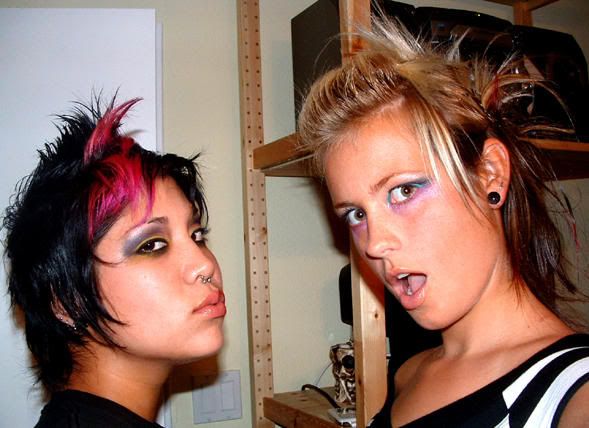 Funky Hairstyles – Spiky Bob Haircuts 2010
Funky Hairstyles – Spiky Bob Haircuts 2010 Funky Hairstyles – Spiky Bob Haircuts 2010
Funky Hairstyles – Spiky Bob Haircuts 2010Taken from http://latest-fashion-hairstyles.blogspot.com/
Hairstyles Design, works hard at bringing you the latest hairstyle trends, tips and news...
 Funky Hairstyles – Spiky Bob Haircuts 2010
Funky Hairstyles – Spiky Bob Haircuts 2010 Funky Hairstyles – Spiky Bob Haircuts 2010
Funky Hairstyles – Spiky Bob Haircuts 2010






Whether you consider this is in or out, think twice about your outfit because there are guys with strong strong opinions!
As a classmate and I try to concentrate in calculus for our last finals, we can’t help but get distracted by these girls in our class that dress – well let’s just say not so pleasant to the eyes. One of our recent text convos looked like this:
Friend: What the hell is that dumb girl wearing? ???
Me: You look at her way too much. Just ignore her.
Friend: She’s in my line to the board… It pains me it’s like one of those things that is so gross you can’t turn away. You just go DAMN what happened?
Me: haha I know how you feel.
Friend: That girl is so trashy! Black bra that you can see. c’mon seriously.
After you’ve read this conversation it sounds like two normal college girls squabbling over some other girl in class. Well, no. It ends up that this friend of mine is actually a guy and no he’s not gay or into fashion and art. Just your typically college boy that wants to get passed tests and finals.
“High heels, ripped jeans, brown belt, see through shirt with the black bra, and the zebra print bag – none of those matched each other!” exclaimed my friend as we were walking out of class. Sighing he adds, “That girl has no fashion sense whatsoever.”
This whole remark made me laugh, but later it got me thinking, do guys really notice that much? This friend of mind never appealed to me as the type that criticizes a girl’s fashion, so I was utterly surprised later when I looked back at the conversation. So I guess straight guys do care more or less about how we dress. Never did I think that, in a town where I live in, I would meet a guy with such a strong opinion about clothes. It gives me all the more reason to think twice about what I wear before I leave the house. haha :)










 Primark has withdrawn a padded bikini for children from sale after complaints from Mumsnet and others. Photograph: Lewis Stickley/PA
Primark has withdrawn a padded bikini for children from sale after complaints from Mumsnet and others. Photograph: Lewis Stickley/PA The pubescent padded bra has been hijacked by the faux-feminist family values brigade as a symbol of moral decline, along with the kiddie pole-dancing kit and the playboy bunny pencil case. With weeks to go before the General Election, politicians are falling over themselves to support Mumsnet's Let Girls Be Girls campaign, which pressures retailers to discontinue products that 'sexualise' young girls. Primark has become a particular focus of public disapproval, and the clothing outlet's pledge to stop stocking padded bikinis for seven-year-olds has been targeted by all three major parties, with David Cameron declaring the products a "completely disgraceful" example of "premature sexualisation".
The pubescent padded bra has been hijacked by the faux-feminist family values brigade as a symbol of moral decline, along with the kiddie pole-dancing kit and the playboy bunny pencil case. With weeks to go before the General Election, politicians are falling over themselves to support Mumsnet's Let Girls Be Girls campaign, which pressures retailers to discontinue products that 'sexualise' young girls. Primark has become a particular focus of public disapproval, and the clothing outlet's pledge to stop stocking padded bikinis for seven-year-olds has been targeted by all three major parties, with David Cameron declaring the products a "completely disgraceful" example of "premature sexualisation".
There is a distinct class element to this puritan agenda. Although the Mumsnet campaign is a broad one, politicians and the press have reserved special disdain for Primark, whose brand has become shorthand for cheap clothing marketed at the working class. This strategy sustains the idea that it is specific groups of young girls who are "sexualised" by corporate culture, and specific, morally bankrupt working-class mothers who buy padded bras for their daughters. There has been no concomitant attack on Marks and Spencer's "Angel" range, which offers a similar demographic of young girls the chance to wear boulder-holders in broderie anglaise just like grandma.
This sort of organised moral outrage is deeply unhelpful to young people negotiating the complex world of adult sexuality. The imprecation to "let girls be girls" imagines a halcyon age of sexual innocence, where young ladies climbed trees and drank ginger pop instead of rummaging delinquently in each other's pornographic pencil cases. In fact, in countries  where children are routinely well fed, a significant minority of seven-year-old girls have already started puberty, and most foster a natural curiosity about bodies and intimacy. Rather than encouraging healthy sexual exploration or promoting education, campaigns to protect girls from "sexualisation" assume that sexuality itself is a corrupting influence on young women.
where children are routinely well fed, a significant minority of seven-year-old girls have already started puberty, and most foster a natural curiosity about bodies and intimacy. Rather than encouraging healthy sexual exploration or promoting education, campaigns to protect girls from "sexualisation" assume that sexuality itself is a corrupting influence on young women.
The notion of "sexualisation" deserves serious critical unpacking. The term envisions girl children as blank erotic slates upon which sexuality can only ever be violently imposed. This narrow vision of sexuality leaves no room for young girls to explore authentic desire at their own pace, insisting instead that girls need to be protectedfrom erotic influence, while boys, presumably, are free to fiddle with themselves to their hearts' content.
 Far from protecting young girls, the "anti-sexualisation" agenda actually serves a culture that shames girls if they have sexual feelings of their own while fetishising them as objects of erotic capital. The pornographic and advertising industries routinely infantilise adult women in an erotic context: in 2008, catwalk model Lily Cole infamously posed nude for French Playboy cuddling a teddy bear and licking a lollipop. Corporate visions of pubescent sexuality are marketed to children and adults alike as ritualised acts of erotic drag, and from an early age, young girls have a profound understanding that such sexual performance must be undertaken if we are not to be socially punished.
Far from protecting young girls, the "anti-sexualisation" agenda actually serves a culture that shames girls if they have sexual feelings of their own while fetishising them as objects of erotic capital. The pornographic and advertising industries routinely infantilise adult women in an erotic context: in 2008, catwalk model Lily Cole infamously posed nude for French Playboy cuddling a teddy bear and licking a lollipop. Corporate visions of pubescent sexuality are marketed to children and adults alike as ritualised acts of erotic drag, and from an early age, young girls have a profound understanding that such sexual performance must be undertaken if we are not to be socially punished.
I would have killed for a padded bra when I was in primary school, if only to give an extra boost to the wodges of toilet roll I had already begun to stuff into my crop-top. Like many girls, I was teased mercilessly for my flat chest by boys with undescended testicles who had already discovered that the best way to torture their female classmates was to mock us for not being sexy enough. A DIY Andrex bosom offered some protection; the handful of my schoolmates who had grown real breasts had no such luck, and were groped, harassed and dogged by cries of "slut" and "slag". For youn g women, sexual shame is learned in the playground, where we are schooled to suppress our authentic bodily appetites and mimic, instead, an adult ideal of erotic capital.
g women, sexual shame is learned in the playground, where we are schooled to suppress our authentic bodily appetites and mimic, instead, an adult ideal of erotic capital.
This ugly world of performative erotic control is made more confusing by a vociferous moral lobby in which adults talk to other adults about what young girls should be permitted to wear, say and do. The online mumocracy's call for retailers to "show parents that their company believes that children should be allowed to be children" is irrelevant to the real experiences of girls growing up in a world where our sexual impulses are stolen and sold back to us.
Padded bras for preteens are not the problem. The problem is a culture of prosthetic, commodified female sexual performance, a culture which morally posturing politicians appear to deem perfectly acceptable as long as it is not 'premature'. By assuming that sexuality can only ever be imposed upon girl children, campaigns to 'let girls be girls' ignore the fact that late capitalism refuses to let women be women – at any age.



